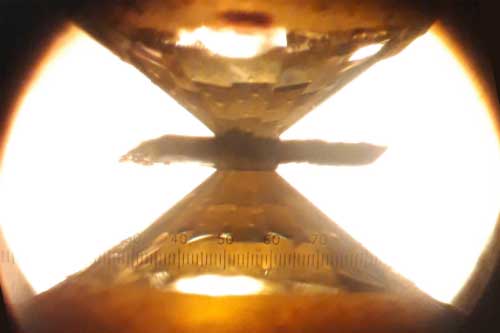Carbon is a key component of all known life on Earth, representing approximately 45-50% of all dry biomass. It is taken into Earth’s interior by subduction, where it drastically lowers the melting point of the solid mantle, forming carbonated melts (carbon-rich molten rocks) in the shallow mantle, fuelling surface volcanoes.
Carbonate minerals may also be transported much deeper into the Earth, reaching the lower mantle, but what happens next is uncertain.
To find out the answer, scientists at the University of Bristol have recreated those conditions in the lab using sophisticated technology. In a recent study, they have uncovered new clues about what happens to carbonate minerals when they are transported into the mantle via subduction of the oceanic crust.
The study reveals a barrier to the subduction of carbonate beyond depths of around 1,000km, where it reacts with silica in the oceanic crust to form diamonds that are stored in the deep Earth over geological timescales.
Scientists subjected synthetic carbonate rocks to very high pressures and temperatures comparable to deep Earth conditions of up to 90 GPa (about 900,000 atmospheres) and 2000 degrees C using a laser-heated diamond anvil cell. They found that carbonate remains stable up to depths of 1,000-1,300km, almost halfway to the core.

Under these conditions carbonate at that point responds with encompassing silica to frame a mineral known as bridgmanite, which shapes the greater part of the Earth’s mantle. The carbon discharged by this reaction is as strong carbon dioxide. As the hot encompassing mantle, in the long run, warms up the subducted section, this strong carbon dioxide separates to shape superdeep diamonds.
Dr James Drewitt from the School of Earth Sciences explains: “Do carbonate minerals remain stable through the Earth’s lower mantle, and if not, what pressure/temperature changes does it take to spark reactions between the minerals and what do they look like? These are the questions we wanted to find the answers to – and the only way to get those answers was to reproduce the conditions of the Earth’s interior.”
“Eventually the superdeep diamonds could be returned to the surface in upwelling mantle plumes, and this process could represent one of the sources of superdeep diamonds that we find at the surface and which provide the only direct evidence we have of the composition of the deep earth.”
“This is exciting because the deepest humans have ever been able to drill is about 12 km, less than half the depth of Earth’s crust. This pales in comparison to the massive scale of Earth’s mantle, which extends to nearly 3,000 km depth.”
Using a diamond anvil cell, scientists were able to generate pressures equivalent to those found at these depths, loading samples under a microscope into a pressure chamber drilled out of a metal gasket which is then compressed between the gem quality, brilliant cut diamond anvils.
Scientists then analyzed the crystal structure of those samples using x-ray diffraction at the UK synchrotron facility in Oxfordshire.
Dr. Drewitt said, “However, we cannot adequately test or understand current models of the dynamic behavior of this water-rich molten rock because we do not know their composition or their physical properties. The experiments at extreme conditions and advanced computer simulations that we are currently working on will help to resolve these problems.”
Their results are published open access in Earth and Planetary Science Letters.
